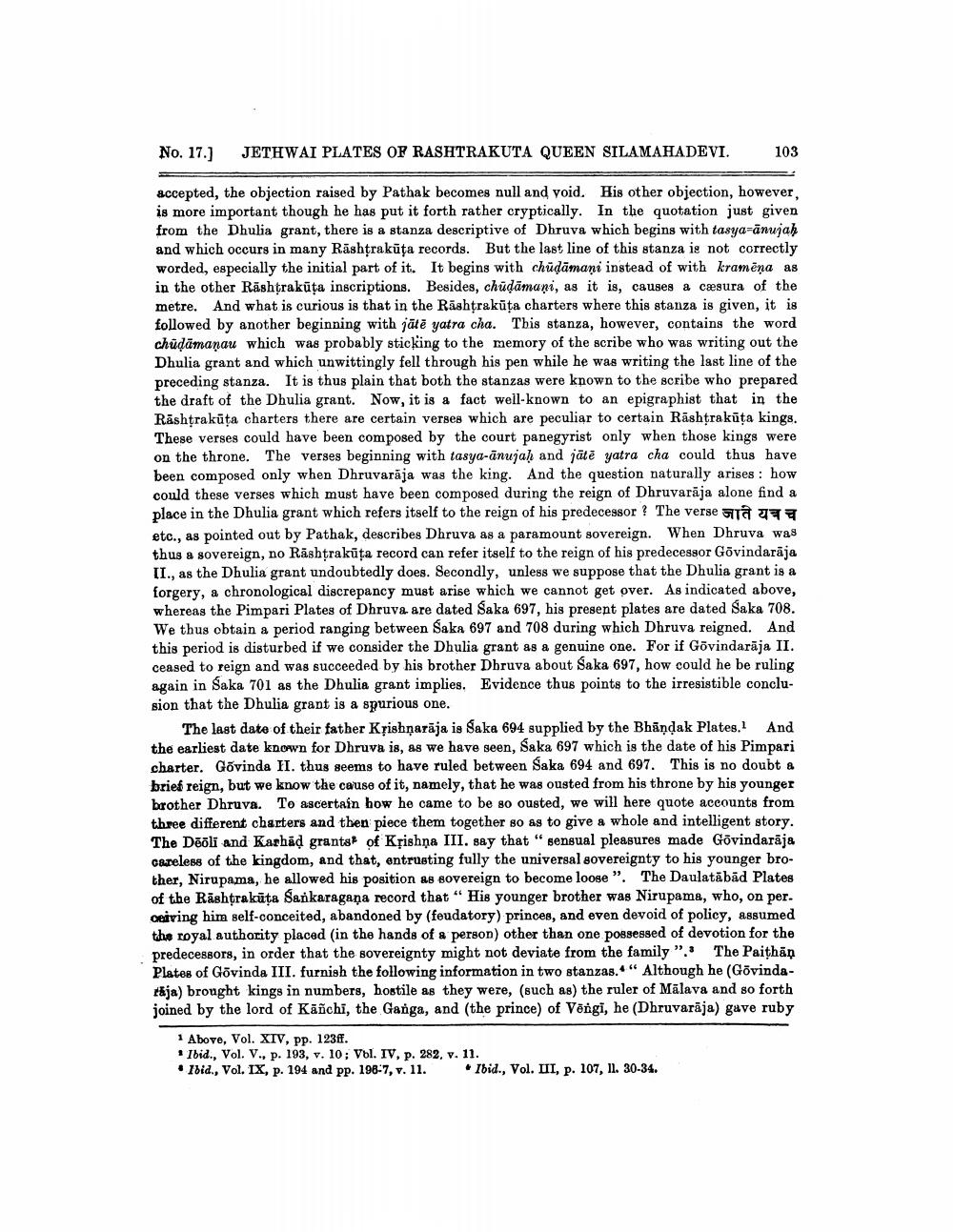________________
No. 17.)
JETHWAI PLATES OF RASHTRAKUTA QUEEN SILAMAHADEVI.
103
accepted, the objection raised by Pathak becomes null and void. His other objection, however, is more important though he has put it forth rather cryptically. In the quotation just given from the Dhulia grant, there is a stanza descriptive of Dhruva which begins with tasya-ānujak and which occurs in many Rashtrakūta records. But the last line of this stanza is not correctly worded, especially the initial part of it. It begins with chūdāmani instead of with kramēna as in the other Rāshtrakūta inscriptions. Besides, chūļāmani, as it is, causes & cæsura of the metre. And what is curious is that in the Rāshţrakūta charters where this stanza is given, it is followed by another beginning with jātē yatra cha. This stanza, however, contains the word chúļāmanau which was probably sticking to the memory of the scribe who was writing out the Dhulia grant and which unwittingly fell through his pen while he was writing the last line of the preceding stanza. It is thus plain that both the stanzas were known to the scribe who prepared the draft of the Dhulia grant. Now, it is a fact well-known to an epigraphist that in the Rashtrakūta charters there are certain verses which are peculiar to certain Rāshtrakūta kings. These verses could have been composed by the court panegyrist only when those kings were on the throne. The verses beginning with tasya-ānujaḥ and jātē yatra cha could thus have been composed only when Dhruvarāja was the king. And the question naturally arises : how could these verses which must have been composed during the reign of Dhruvarāja alone find a place in the Dhulia grant which refers itself to the reign of his predecessor ? The verse 2 etc., as pointed out by Pathak, describes Dhruva as a paramount sovereign. When Dhruva was thus a sovereign, no Rāshţrakūta record can refer itself to the reign of his predecessor Govindaraja II., as the Dhulia grant undoubtedly does. Secondly, unless we suppose that the Dhulia grant is a forgery, a chronological discrepancy must arise which we cannot get over. As indicated above, whereas the Pimpari Plates of Dhruva are dated Saka 697, his present plates are dated Saka 708. We thus obtain a period ranging between Saka 697 and 708 during which Dhruva reigned. And this period is disturbed if we consider the Dhulia grant as a genuine one. For if Govindarāja II. ceased to reign and was succeeded by his brother Dhruva about Saka 697, how could he be ruling again in Saka 701 as the Dhulia grant implies. Evidence thus points to the irresistible conclusion that the Dhulia grant is a spurious one.
The last date of their father Krishnaraja is Saka 694 supplied by the Bhandak Plates. And the earliest date known for Dhruva is, as we have seen, Saka 697 which is the date of his Pimpari charter. Govinda II. thus seems to have ruled between Saka 694 and 697. This is no doubt & brief reign, but we know the cause of it, namely, that he was ousted from his throne by his younger brother Dhruva. To ascertain how he came to be so ousted, we will here quote accounts from three different charters and then piece them together so as to give a whole and intelligent story. The Dēõli and Kashād grants of Krishna III. say that " sensual pleasures made Govindarāja Careless of the kingdom, and that, entrusting fully the universal sovereignty to his younger brother, Nirupama, he allowed his position as sovereign to become loose". The Daulatābād Plates of the Rashtrakūta Sankaragana record that " His younger brother was Nirupama, who, on per. ceiving him self-conceited, abandoned by (feudatory) princes, and even devoid of policy, assumed the royal authority placed in the hands of a person) other than one possessed of devotion for the predecessors, in order that the sovereignty might not deviate from the family". The Paithan Plates of Govinda III. furnish the following information in two stanzas." Although he (Govindatája) brought kings in numbers, hostile as they were, (such as) the ruler of Mālava and so forth joined by the lord of Kāñchi, the Ganga, and the prince) of Vēngi, he (Dhruvarāja) gave ruby
1 Above, Vol. XIV, pp. 123ff. * Ibid., Vol. V., p. 193, v. 10; Vol. IV, p. 282, v. 11. • Ibid., Vol. IX, p. 194 and pp. 198-7, v. 11. Ibid., Vol. III, p. 107, 11. 30-34.




